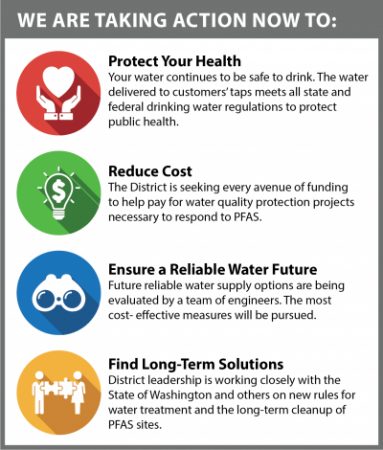PFAS Updated EPA MCL
Lakewood Water District response to the EPA's new MCL (click for more information)
This morning, the Environmental Protection Agency (EPA) published its final rule on establishing Maximum Contaminant Levels (MCLs) for PFAS in drinking water. The final rule has been years in the making and establishes enforceable limits that are significantly lower than past EPA guidelines. This significant change will continue to be in the news and is certain to raise some concerns and questions. Lakewood Water District continues our dedication to being transparent and committed to providing safe drinking water to our community.
“Lakewood Water District is committed to both the protection of public health, and we share EPA’s desire to keep harmful levels of PFAS out of the nation’s drinking water. We support setting national drinking water standards for PFAS that protect all consumers, including the most sensitive populations. We also stand for strong source water protection to prevent PFAS contamination and increased investment in PFAS research. We stand for transparency, and support requirements for utilities to actively share PFAS monitoring results and other water quality information with consumers.”
PFAS: What you need to know
Lakewood Water District has detected PFAS in groundwater at certain locations in the District’s water supply system. PFAS are a group of human-made chemicals that have the potential to adversely affect human health and the environment. The source of the PFAS in the groundwater is firefighting foam that was used at JBLM for decades.
WE ARE TAKING ACTION NOW TO:
Protect Your Health
Your water continues to be safe to drink. The water delivered to customers’ taps meets all state and federal drinking water regulations to protect public health.
Reduce Cost
The District is seeking every avenue of funding to help pay for water quality protection projects necessary to respond to PFAS.
Ensure a Reliable Water Future
Future reliable water supply options are being evaluated by a team of engineers. The most cost-effective measures will be pursued.
Find Long-Term Solutions
District leadership is working closely with the State of Washington and others on new rules for water treatment and the long-term cleanup of PFAS sites.
Is Lakewood Water District’s water safe to drink?
Your water continues to be safe to drink. The water delivered to customers’ taps meets all state and federal drinking water regulations to protect public health.
What are PFAS?
PFAS are a group of human-made chemicals that have the potential to adversely affect human health and the environment. PFAS have been manufactured and used in the US and around the world since the 1950s in food packaging, non-stick cookware, and firefighting foam.
What regulations exist for PFAS?
The US Environmental Protection Agency (EPA) has a health advisory level for PFAS that offers a margin of protection for all people throughout their lives from adverse health effects resulting from exposure to PFAS in drinking water. The Washington Department of Health is in the process of developing State Action Levels for PFAS compounds. The new State Action Levels are likely to be in place in 2021.
How does PFAS affect my health?
PFAS chemicals build up over time and can cause cancer and other illnesses when they reach higher concentrations in the body. Concentrations of PFAS in drinking water are very low but can contribute to levels found in people’s bodies from commercial sources.
What can you do about PFAS?
PFAS can be reduced with home filters that use granular activated carbon (GAC), the same type of treatment the District has installed in the water system.
We also encourage you to stay informed!
We continue to update our website with information on new regulatory guidance and other PFAS-related information: www.LakewoodWater.Org
Correcting PFAS Myths: Misperceptions Risk Higher Clean-Up Costs for Water Ratepayers - www.awwa.org
Washington State Department of Health has an informative PFAS website: www.doh.wa.gov/CommunityandEnvironment/Contaminants/PFAS
The Environmental Protection Agency also has PFAS information: https://www.epa.gov/ground-water-and-drinking-water/drinking-water-health-advisories-pfoa-and-pfos
If you have any questions about PFAS in the District’s water system, please contact our Engineering Manager, Marshall Meyer, at mmeyer@lakewoodwater.org

